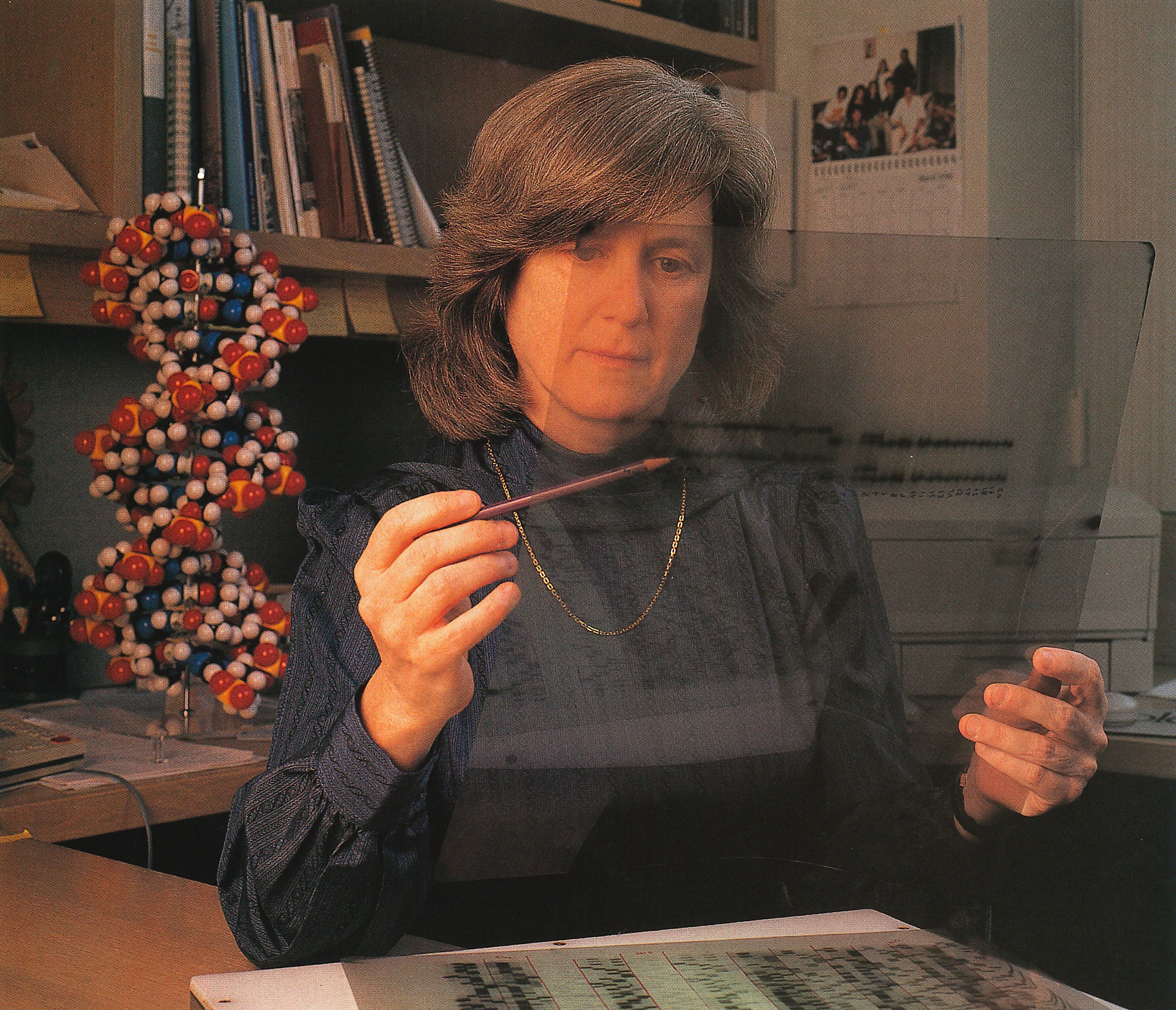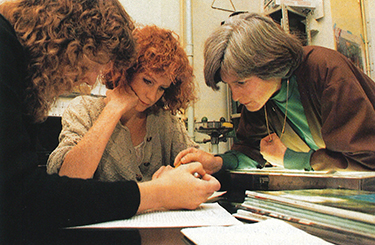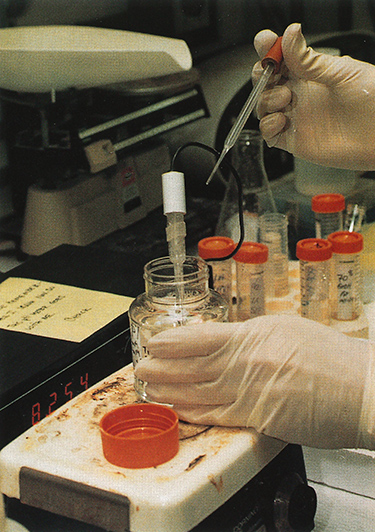
Cancer detective Cancer detective After finding breast-cancer gene, UW professor stays on the case
After finding a genetic link to breast cancer, UW Professor Mary-Claire King stays on the case.
By Laurie McHale | Lead photo by Mary Levin | Sept. 1996 issue
In a sense, Mary-Claire King began preparing to do battle with cancer when she was just fifteen years old, as she watched her best friend die of a kidney tumor. "We had been friends since age seven," she recalls. "Her death was devastating. I didn't know she had cancer: I just knew she was very ill and in terrible pain, and then she died. It seemed so unfair. It wasn't a conscious decision, but I said to myself, something needs to be done. It's the little pebbles that make a path."
Three decades later, King’s youthful resolve led to spectacular results, with her proof in 1990 of the existence of the first gene for hereditary breast cancer, now known as BRCA1.
“She did the seminal work,” says Leroy Hood, William Gates professor and chair of molecular biotechnology at the UW, and a major factor in King’s decision last year to leave the University of California at Berkeley and accept an appointment at the University of Washington. “It let the world get into the hunt to pinpoint the gene.”
“Mary-Claire has made extremely important scientific contributions, beyond the search for a cure for breast cancer,” adds Maynard Olson. “She changed the way people think about human genetics.” Olson, UW professor of molecular biotechnology and medical genetics, is a prime mover in the Human Genome Project, the huge international effort to map the entire genetic makeup of the human being.
Until King’s lab mapped BRCA1, the best success in using DNA techniques to study human genetics came in analyzing diseases with simple patterns of inheritance—like Huntington’s disease, where those who receive the mutation from one parent inevitably succumb to the disease—or like sickle-cell anemia and cystic fibrosis, where those who inherit recessive genes from both parents get the disease.
“There has been a mythology that breast cancer has been understudied. In actual fact there has been intense research and only slight advances in understanding it. Mary-Claire broke the logjam.”
Maynard Olson, UW professor of molecular biotechnology and medical genetics
“Breast cancer is a more typical disease than those textbook disorders,” says Olson. “Genetics is intermingled with environmental and lifestyle factors. Family history is important, but not predictive in the same way.” Other diseases in which inheritance and environment are dual influences include heart disease, hypertension, stroke, Alzheimer’s disease, and some mental illnesses.
“Before BRCA1, there was a widespread view that diseases like breast cancer were caused by multiple genes that interact with environmental factors. This didn’t provide geneticists with a clear road ahead,” says Olson. “In the midst of that, Mary-Claire’s initial report was a jolt. She told a different story: that in carefully selected families she could find a fairly simple genetic link for breast cancer. It provided us with a powerful path forward. We now know that many important diseases can be attacked in the same way.
“There has been a mythology that breast cancer has been understudied. In actual fact there has been intense research and only slight advances in understanding it. Mary-Claire broke the logjam.”

Professor Mary-Claire King (right) searches for mutations that might unmask the BRCA1 gene. With her in her old Berkeley lab are researchers Lori Friedman and Sarah Rowell. Photo by Dennis Galloway.
After King’s lab showed that BRCA1 existed on chromosome 17 and was responsible for many inherited breast and ovarian cancers, the race was on to clone the gene and pinpoint its exact location. Mark Skolnick of the University of Utah was first to the finish line. “Cloning the gene is not the hardest part of the task,” says Olson. “It’s labor-intensive, but it happens sooner or later. Within 10 years, that phase will no longer be necessary, because the whole human genome will have been sequenced.”
“When Mary-Claire lost the race to clone the gene, everyone expected her to be disappointed,” says Piri Welcsh, a post-doctoral fellow in King’s lab. “I imagine there was some disappointment, but we all had the same reaction. It meant we could now really start working on the biology of breast cancer. We can now determine how alteration in the gene creates breast cancer.”
Last February, King and researchers at Vanderbilt University took the research a step further, reporting they had found the first direct evidence that the same gene can halt—and in some cases reverse—breast and ovarian cancers. Using mice inoculated with human breast cancer cells, they showed that normal BRCA1 secretes a protein that appears to inhibit certain cells from engaging in uncontrolled division and growth.
Uncoiling the conundrum of breast cancer and other genetic mysteries is but one consuming interest for Mary-Claire King. She plays many other roles, as teacher, mother, mentor and human rights activist.
Politically active since her days as a Berkeley graduate student in the Vietnam-era, she worked briefly for Ralph Nader’s consumer interests group before earning her Ph.D. She taught science in Chile on a Ford Foundation grant and participated in research programs funded by the Salvador Allende government. In the aftermath of the 1973 military coup and assassination of Allende, some of her friends and students were murdered or forced to flee.
Today, with the rise of democracy in Latin America, investigators use her lab’s expertise in forensic genetics to identify the remains of people murdered in El Salvador, Mexico and especially in Argentina.
King has an ongoing project to assist the “Abuelas,” the Grandmothers of the Plaza de Mayo in Buenos Aires. During Argentina’s military dictatorship of the 1970s and early 1980s, thousands of activists disappeared and their children were consigned to orphanages or illegally adopted by military families. Today, the grandparents—the parents of “the Disappeared”—seek to be reunited with the children of their lost sons and daughters. A genetic test, one of the same techniques used in criminal trials to identify perpetrators of crimes, is often the only way to confirm that link. The test matches mitochondrial DNA sequences which are maternally inherited.
“The important thing is learning how to do something and putting the puzzle together, whether it's building a house or finding a cure for cancer.”
Mary-Claire King
King recently invited a new post-doctoral fellow into her lab, Michele Harvey, to further her work in identifying the victims of human rights abuses, with funding from the organization Physicians for Human Rights. As well as continuing work in Argentina, they will work to identify the remains of murdered war victims in Bosnia, Rwanda, and Ethiopia, amassing genetic evidence for use in international war crimes trials.
“There is a human aspect to Mary-Claire’s scientific work that transforms it,” says Harvey, “whether it’s with breast cancer patients and their families, or with the families of the Disappeared. She knows the families, and the stories behind them. She realizes that in Argentina people have risked their lives to give blood samples for her work.”
“Mary-Claire’s scientific interest is more an outcropping of her humanism than of a natural bent toward science,” says her younger brother, Paul King, who is CEO of Vanalco, an aluminum smelter in Vancouver, Wash. “She always had a quantitative bent and scientific ability, but she was very good at everything. She had the desire to take her math ability and apply it to do some good.”
Now 50, King grew up in Wilmette, Ill., an upper middle class suburb of Chicago. She attended New Trier Township High School, regarded as one of the best public high schools in the country. She majored in mathematics at Carleton College in Minnesota, but modestly claims she was not a top student. “I was consistently a B math student,” she says.

Much genomic work was once done by hand. Today, much more is automated. Photo by Dennis Galloway.
The chairman emeritus of Carleton’s math department, John Dyer-Bennett, admits he didn’t really remember King as a standout student until he refreshed his memory for introductory remarks he gave at a convocation in 1992, when she received an honorary doctorate from Carleton.
Her grades were good enough to garner her a bachelor’s degree by age 19, along with admission to Berkeley’s graduate program in genetics, which led her eventually to the lab of her mentor and Ph.D. advisor, the late Allan C. Wilson. She asserts she was an average graduate student in genetics—albeit in some pretty bright company.
“You don’t have to be a star as a student,” she says. “It’s more a matter of feeling your way. I just stuck with it. You do things well if you’re motivated. I’ll grant that I work very hard, and I believe work has a value in itself. Some years ago, my then-husband’s family and I built a house from the ground up on a ranch in the Rockies. The important thing is learning how to do something and putting the puzzle together, whether it’s building a house or finding a cure for cancer.
“To do science, you have to not be intimidated by failure, because you’re always getting things wrong. Once in a blue moon, everything goes right. Blue moons are rare, but they’re very important in science.”
King joined the UW faculty in 1995, arriving in Seattle last summer and accepting a joint appointment as professor of medical genetics in the UW School of Medicine and professor of genetics in the College of Arts and Sciences. She was accompanied by 12 graduate students and post-doctoral fellows from her Berkeley lab, all supported by federal research grants or fellowships. Grants and fellowships also pay half of King’s salary at the UW, and bring in an estimated $1 million in research funds.
“The move was harder than I anticipated, both personally and professionally, because I had 30 years of history at Berkeley,” says King. “But it’s been a very good decision.”
At Berkeley, King’s lab was the only one working in human genetics and the closest medical school was a long drive across the Bay to UC-San Francisco. At the UW, her School of Medicine colleagues are a stroll down the hall or up a flight of stairs.
“I had more people drop in at the lab in my first month here than in five years at Berkeley,” she recalls. “There’s a wonderful redundancy here: it’s really a privileged situation to work here amid all this talent. You reach a critical mass, and the ideas ferment. Science is like a cauldron. You have to let the ideas gently bubble, and percolate to the surface.”
While she’s gratified to have access to the high-powered technological resources in the Health Sciences Center’s new K-Wing, they were not the critical factors in her decision to move. “It’s not just the hardware, it’s imaginative ways of thinking,” she says. “You become so comfortable where you are that you can’t break out of the mold. I needed to think with fresh perspectives about biology. I needed clinical colleagues, not the isolation I worked in there. The UW is clearly among the best places to do this work.”
The UW had sought her for more than a year and a half before King gave the thumbs up, sending the moving vans north and the champagne corks popping at the UW.
“We were very excited at the opportunity to recruit Mary-Claire,” says Paul Ramsey, chairman of the Department of Medicine. “We’re pleased with the interactive nature of her position, with her joint appointment in the College of Arts and Sciences, where she teaches undergraduates, as well as her primary appointment in medical genetics.”
In the view of both Leroy Hood and Maynard Olson, enticing King to the UW can be attributed in part to the $12 million donated in 1991 by Microsoft CEO Bill Gates to launch the Department of Molecular Biotechnology.
“She has a combination of scientific persistence and intuition, and she finally got to the gene.”
Arno Motulsky, UW professor of medicine and genetics
“The seed money from Bill Gates has helped attract a number of people here,” says Hood.
“If seed money is used effectively, the programs can pay for themselves with external grant money,” says Olson. “But there’s no way to get into the game without the seed money. It’s a genuine success story.”
“I’ve known Mary-Claire since the beginning of her career,” says Arno Motulsky, UW professor of medicine and genetics. “She has a combination of scientific persistence and intuition, and she finally got to the gene. She unites expertise in epidemiology, molecular biology and genetics, focused on a single disease.”
King’s lab is seeking to solve other genetic mysteries as well, notably an inherited form of deafness. Post-doctoral fellow Eric Lynch is studying an extended family of some 300 members in Costa Rica, of whom approximately half carry a gene that causes them to lose their hearing by their thirties. Lynch mapped the gene to an area of chromosome 5 in 1992, and has been working to pinpoint it since. “We’re at the end stage,” he says. “There will be a eureka moment.”
While cloning the gene may lead to a cure for this family’s deafness (thus far they seem to be unique in the world), Lynch says that, just as importantly, understanding the genetic mechanism involved in their hearing loss will help scientists determine which genes are involved in normal hearing.
The King lab also does work on the genetics of HIV and rheumatoid arthritis, but she will continue to concentrate her efforts on BRCA1, and its ties to breast, ovarian and possibly prostate cancer.
“She understands that human genetics is about people,” continues Olson. “Many scientists don’t see intuitively the huge jump we take when we move from the genetics of flies to the genetics of people, but there’s a need for a strong human dimension to human genetics. It could be argued that it’s the most exciting thing happening in science, because it’s about us. It touches incredibly personal parts of our lives. We’re fortunate to have human geneticists like Mary-Claire King who have the ability to meet people where they are and understand the human dimension of their scientific pursuits.”
A role model for women scientists
As one of the world’s preeminent medical researchers, Mary-Claire King has become a role model for the woman as scientist. Never one to closet herself away in her lab, she travels extensively as an advocate for breast cancer research, frequently under the auspices of the Susan G. Komen Breast Cancer Foundation or the American Cancer Society.
Two years ago the society named her the first Walt Disney-American Cancer Society Professor for Breast Cancer Research, funded with a $1 million endowment from the widow of Walt Disney.
A born teacher who can address audiences at many levels, King teaches genetics to both graduates and undergraduates, including a popular course for non-majors. “Teaching is taken very seriously here at the UW,” she comments. “I also travel a lot as a visiting professor. It’s especially important for women scientists to do this. Just being there makes an important statement.”
“She’s a passionate advocate of women in science,” says Leroy Hood. “That’s a wonderful addition to the UW.”
She travels practically every weekend in her advocacy role, sometimes prevailing on policy boards to accommodate her heavy schedule by holding weekend meetings.
At the entrance to her lab, a wobbly revolving rack reflects its collegial atmosphere, displaying an array of postcards from lab staffers’ travels and cards marking milestones like birthdays, housewarmings, weddings and births.
“She finds the balance between being a boss, a godmother and a friend,” says lab post-doc Elizabeth Schubert. “The King lab is the friendliest one I know. We had a dinner for someone’s birthday and 14 of us showed up on a Monday night. Mary-Claire is enough older than we are that she can give us advice. She’s a wonderful teacher who makes things clear in a short time. She wants to see our data, and gets immediately to the heart of the matter.”
“Mary-Claire is one of the few female principal investigators with a large lab,” says one of the few males in her lab, Eric Lynch. “She’s a wonderful role model, and it makes the atmosphere quite special. We celebrate every holiday together.”
King says it’s now easier for a woman to forge a successful career as a scientist than it was for generations past. “But there’s one reality that hasn’t changed,” she says. “The definitive difference is in being a mother. It could be a father, but the reality is it’s almost always the mother.”
A single parent since her daughter Emily was five, King says there’s no way to properly care for a child and accomplish as much in one’s career as one otherwise would. “You get a sense of never doing anything well. Emily was magnificent, but a small child shouldn’t have to be so patient and understanding.”
King recalls with a rueful smile that Emily taped a sign to a child-sized chair next to her storybooks in a corner of her mother’s office. “It said ‘Student Waiting Chair for Slow Teacher,’ because I was forever asking her to wait. I spent a great deal of life working out schedules.
“Emily is 21 now, a wonderful person and a student at Brown, studying the evolution and expression of Old English, looking at the contributions of five languages. We’ve taken totally different paths, but it’s not that different from the way a geneticist works.”
And for King, being a scientist is not that different from the way a mother works: teaching, mentoring, caring, fixing what hurts, and making things better.